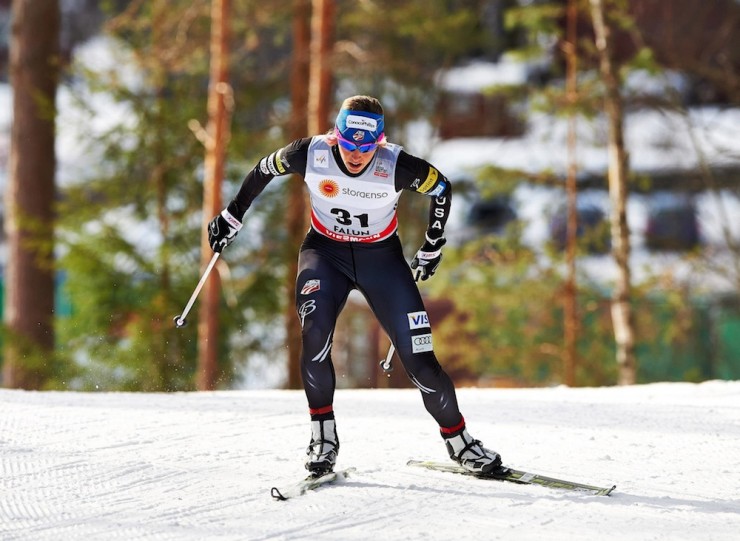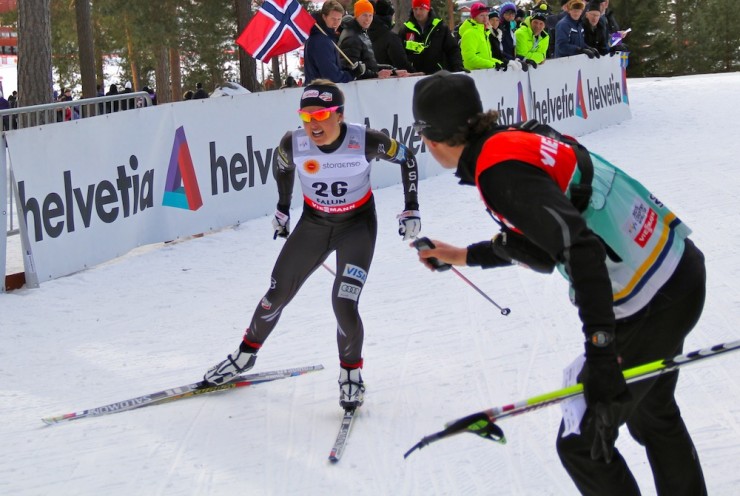
In a race that held a lot of unknowns for the entire World Cup Finals field before it began, the freestyle prologue stage that was held on Friday in Falun, Sweden, was a particularly important moment of truth for the American women. After a mediocre performance in the classic sprint two days prior, a shorter event in the team’s generally stronger disciple presented a more weighty test for a group of athletes that, like the entire field, is getting ready to be done racing for the season.
“I was feeling tired and pretty mentally done in Lahti,” said Jessie Diggins. “I was like, ‘Man, I’m pretty ready to go home.”
Somewhere there must have been energy to burn, for it sparked to life on Friday to help Kikkan Randall, Holly Brooks and Diggins post three top-10 performances for the U.S. Randall landed on the podium with a third-place finish and Brooks and Diggins went back-to-back in seventh and eighth, respectively. Liz Stephen crossed the finish line in 20th to put four team members in the top 20.
“It was a great race. Putting three in the top eight and Liz in 20th was a great day for us,” said U.S. Ski Team women’s coach Matt Whitcomb. “For Kikkan it was no surprise that she could unleash something like that, but it was refreshing for her to come up with that effort this far into the season and the same is true for Jessie and Holly, who were in need of a good result to bring back some confidence at the end of the year.”
The Falun course definitely favored a team like the Americans who are usually good at climbing and good at short distances on skate skis. The track, only 2.5 k long with the readjustments made at the insistence of the athletes on Thursday night, essentially climbed out of the stadium to the top of the Mördarbakken hill 1.2 k from the start. The course then spun athletes in a 180-degree turn at the crest and shot them back down the other side to navigate the last bit of the windy descent, the one that had first caused the field to protest the course over safety concerns the night before the start. At the bottom of the hill there was still a few rolling transitions to get through before it was over, requiring some amount of energy conservation to avoid bleeding time in the last 500 meters.
Randall thought she played the conservation game right, posting the fourth-fastest split at the top of the Mördarbakken, 5.5 seconds down to Astrid Jacobsen (NOR). She moved up a place as others dropped back to finish 6.6 seconds behind Marit Bjørgen’s winning time.
“Obviously today showed I’m in a good place,” Randall said. “Classic is all over the place these days so who knows about tomorrow, but basically I just want to show up at the starting line, ski like crazy, and it’ll be what it’ll be.”
It’s hard to say whether the late-night negotiations between athletes and the race jury affected Randall. She admitted to feeling fatigued in her warm-up but OK once the race got underway. As the only athlete representative present at World Cup Finals this week, the responsibility of organizing the athlete protest over the original course fell largely to Randall the night before.
Whitcomb didn’t think she showed significant signs of fatigue during the race.
“Kikkan has a pretty high capacity to carry stress like that, but there was no doubt that it was a weighty effort on her part,” Whitcomb said. “These guys kind of inherited a problem that maybe could have been dealt with beforehand, but they had to deal with it last night and I was impressed with their ability to roll through the punches with a cool attitude. It took a big toll on everybody, not just Kikkan and the people leading those meetings… We came out of it OK.”
Randall moved herself from 22nd to ninth in the mini-tour standings with her prologue performance.

Behind the team’s leader, two teammates were ecstatic with confidence-building races again at the tail end of the season. Brooks, whose time of 6:15.5 brought her a seventh-place finish, 12.3 seconds behind Bjørgen, has been waiting to be back in the top-ten since she last raced in Sweden in November and was “psyched” to have returned to the position.
“It’s been a little while since I’ve had a really good one, so I’m pumped,” she said.
Brooks’ ability to set a concrete strategy for the course was, like everyone else’s, waylaid somewhat by the fact that the newly modified course was closed prior to the start to conserve snow. In general, she attacked it almost like she would a sprint race.
“I think it was Astrid [Jacobsen] that said it’s like 1% less than sprint pace,” Brooks said. “I love prologues, especially skate prologues. They’re probably my favorite race, and I think about going maybe 1% less than sprint pace but holding really good technique, and that tactic usually works really well for me. Sometimes in sprint races you get too jumbled and your technique kind of falls apart because you’re trying to go too fast, so I really like the prologue length.”
Brooks observed that the earlier starters took about six and a half minutes to finish the course and surmised that “OK, if it’s a six minute race you really have to go,” she said. “And I think the course skied a bit easier than I anticipated so you had to go pretty hard from the start.”
Brooks eased off on the rerouted descent, but also figured everyone probably did after all the pre-race hype about the downhill.
“Just talking to some of the other girls, others were a little reluctant,” she said. “And talking about it more probably made us a little more paranoid than we needed to be… I definitely bled some time there but I figured it was better than falling and losing a ton of time.”
Just a few seconds behind her, Diggins had a similar reaction to her eighth place-finish: satisfied to know that she can still crack the top-10 threshold this late in the season.
“It’s really nice to know that my body was feeling ready to go today and that everything wasn’t quite shut down just yet,” she said. “It’s always nice to have a good race at the end of the season to kind of end things on a high note, especially having three girls in the top 10… That’s sweet; a really good thing for our team.”
The accomplishment stood in contrast to the way the team ended their Thursday the night before the race. There were three athlete meetings in the lead-up to the prologue that were widely attended by the entire field and when Diggins went to bed on Thursday, “I was actually pretty certain my season was over and that we weren’t going to be racing,” she said, because the jury had not yet responded to the athletes’ final assertion on Thursday night that the course was still not safe enough.
“It was interesting waking up being like, ‘Well, I don’t know if I’ll get to race,” Diggins said. When athletes approved newer changes to the course on Friday morning, “In a way that kind of made us all appreciate getting to race more, because at one point we thought we wouldn’t be at all.”
Behind Diggins, Stephen posted a top-20 as the fourth U.S. women in the prologue. As a distance specialist, Stephen approached the beginning of the race at a relatively conservative pace, and in hindsight wished she had started faster than she did.
“It was a short course, but it was still a hard one, with two good-sized climbs and technical downhill skiing, so not really any rest,” she wrote in an email. “However, six minutes is a really short amount of time to be doing anything, and I think if I could do it over again I would have started faster than I did. The tracks were closed on the downhill and so we didn’t get a chance to preview it, as they were trying to preserve the tracks for our race, so knowing how it would ski, and how quickly it skied, wasn’t quite possible today.”
Overall, Stephen is satisfied with 20th and looking forward to the remaining two stages of World Cup Finals, particularly the final 10 k freestyle pursuit on Sunday.
“The body remembered I still have a few more races to go this season!” she said.
On a six-woman U.S. squad that qualified the Finals, Ida Sargent was the fifth American on Friday in 38th. It was only the third prologue race of her life and she thought she started a might too slow in an effort not to “blow up” like she has before.
“I started conservatively and finished feeling like I had more in the tank,” she said. “The finish line came way too quickly which never happens for me. But hopefully it will be a good warm-up for tomorrow.”
Rosie Brennan, the U.S. starter in the continental cup leader spot, finished 46th in the prologue, 41.9 seconds off Bjørgen’s winning time. This period of World Cup racing has been her first exposure to the circuit and she has been attempting to make a point to evaluate each race in Europe before she sees results. On Friday, Brennan noted she could have probably started more aggressively.
“I am still figuring out how to do prologue. It’s a very tricky distance and I think the strategy changes a lot depending on the course. Today, I think I skied a little too conservatively,” she said. “Also, being an early starter, I wasn’t able to see the times it was taking girls before I started. Looking back and seeing that it only took six minutes, I think I should have pushed harder in many places.”
Brennan has struggled with a lingering back injury for the last few races, but for the prologue she felt “much better.”
World Cup Finals continues on Saturday with a 10 k mass start classic and on Sunday with a 10 k freestyle pursuit.
Audrey Mangan
Audrey Mangan (@audreymangan) is an Associate Editor at FasterSkier and lives in Colorado. She learned to love skiing at home in Western New York.



